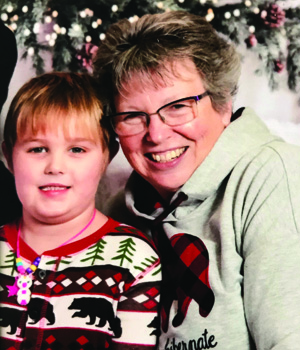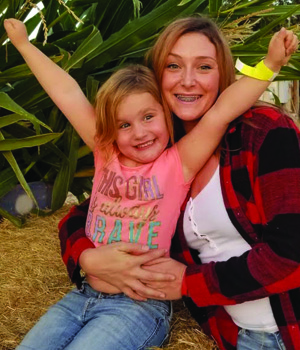

Header image text: Multigen. Oregon's multigenerational approach to fighting poverty.
UMCHS leaders look at the big picture to see what barriers children and families face, understanding that "family" includes every important person in a child's life. Multigen principles are ingrained in how staff engage the families of the 925 children they serve, track progress, solve problems and make changes.
Multigen's first principle is to build trust and empower families. Umatilla-Morrow Head Start Family Engagement Director Suellen Whitlock says, "From the minute they come into the program, we learn what they are doing now that is working for them, and then we build on that together."
UMCHS's focus on unique families also means focusing on equity, another important principle in multigen. Last year, UMCHS discovered a problem with language access for the growing Guatemalan population in the areas they served. Many families spoke Mayan languages, such as K'iche' and Mam, and were struggling to complete paperwork and access services. To address this need, UMCHS will begin using LanguageLine, a remote interpreter service used to communicate with families who speak a wide variety of languages.
Multigen also encourages working together with other organizations to benefit the whole community. UMCHS works with a variety of partners, including school districts and ODHS programs. When partner organizations in Boardman and Pendleton built new learning centers, they made sure Head Start had classrooms to use in their new facilities because they recognize the benefit of early learning to the whole community.
In multigen, tracking outcomes with data and hearing directly from the community are both important. UMCHS uses both quantitative and qualitative data to understand the families they serve. These elements create the “family story” and measure strengths in different areas, such as “family well-being,” “family as advocates” and “family as learners.”
Staff also hear from families directly through the policy council. “Within a year of Head Start involvement, some of the parents become leaders in our agency,” says Suellen Whitlock. She sees these family members as not just people they serve but as “guiding our process for the future.” For example, a policy council member identified a cause of absenteeism — some families didn’t have transportation to bring their child to and from Head Start. This alerted the program that they need to be aware of transportation access and options in each area they serve.
UMCHS understands that no matter how good your data is, good decisions depend on knowing your community. “If we did the same things in John Day that we do in Hermiston, people might not sign up for services. They’re unique communities,” says Suellen Whitlock. Even the playground designs take the community into account – they include elements that reflect local geography or local industries, such as ranching.
Umatilla-Morrow Head Start recognizes each family’s unique composition, strengths and barriers. UMCHS’s family-focused approach to engagement, tracking outcomes and making changes is a natural fit with the principles that guide multigen.
Families come in all shapes and sizes at the Umatilla-Morrow Head Start program. “We might see six or seven different family members supporting a child during the week,” UMCHS Family Engagement Director Suellen Whitlock says. “Extended families are now so much the norm. We have parents, aunts and uncles, grandparents – even great-grandparents – involved.”
Laura and her niece Gracie and Lindsay and her daughter Randie are examples of two multigenerational families the program has embraced since their children were tiny.
Laura and Gracie

In fact, 6-year-old Gracie Tucker-Wall’s parents enrolled in Head Start’s parenting classes before Gracie was born. Head Start adapted its role with the family as Gracie’s support system changed. When Gracie was 2 1/2 years old, her aunt, Laura Tucker, became Gracie’s guardian. ”I was almost 60 years old when I began taking care of Gracie and Head Start came into my life. I needed that time to build a foundation of learning,” Laura says.
Laura started as a Head Start volunteer and is now on the policy council. “Being involved with Head Start made me realize how much empowerment the families get from being here,” she says.
And Gracie? She is in first grade now and “doing so well,” Laura says. In fact, Gracie switched roles from student to teacher to give Laura a lesson on possessive nouns.
Lindsay and Randie

Lindsay Powell-TenEyck’s daughter, Randie McCoy, came to Head Start when Randie was 6 months old and Lindsay was struggling. She says she felt like Head Start was always there for her, her daughter and her grandparents, who take a major role in parenting Randie and are active with the Head Start program.
“My grandparents play a big part; they bring my daughter to Head Start and pick her up. All three generations Zoom for Head Start meetings,” Lindsay says.
“I am so thankful for everything Head Start has helped us do. No matter what I’ve been through, they’ve been here for my daughter, me and my grandparents. They’ve given me parenting classes and even helped me learn to cook and save money. My daughter comes home every day wanting to read and talk.”
Bobbi, Lindsay’s Head Start Family Advocate, says, “Make no mistake, Lindsay is doing so much of the work for her daughter. Behind her and every child is a whole support system.”
Email Multigen.Info@dhsoha.state.or.us with your stories of using the multigen approach.